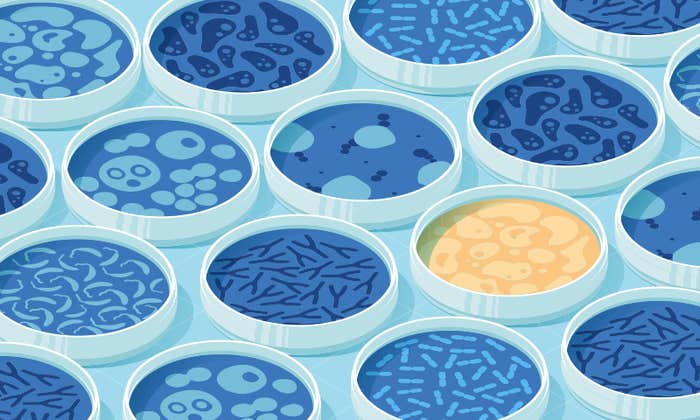Solving the world’s biggest problems is kid’s work. Assuming the kid is Sahil Doshi, a ninth-grader from Pittsburgh who invented a low-cost battery that cuts greenhouse gases. In 2014 Doshi was named America’s Top Young Scientist for developing what he calls PolluCell, which uses a carbon dioxide solution to generate electricity. Doshi was inspired by conversations with his father, a doctor, and trips to poor and polluted towns in India. He was awarded $25,000 for his invention.
Sahil, 14, spent a significant part of last year developing his eco-friendly battery. In water, carbon dioxide forms carbonate and bicarbonate ions—charged particles that can generate an electrical current. Sahil began his experiments on a countertop of his mother’s kitchen, but that didn’t last long. Soon he took over every surface. “He started with just a couple of glasses on the corner of the counter, and then he took over the whole counter, and the next counter, and the island until he finally occupied the entire kitchen,” says Sahil’s mother Ami Doshi. “The only thing I had left in the kitchen was the stove.”
After Discovery Education 3M Young Scientist Challenge accepted his initial proposal, Sahil spent his summer working with his mentor, James Jonza, a staff scientist at 3M, over the phone and Skype to improve the idea. Later that year, he traveled to Saint Paul, Minnesota to compete in the challenge. He’ll save the prize money for his college education, he says.
When he is not assembling batteries in the kitchen, Sahil plays tennis, golf, and guitar. “I’m more of a classically trained guitarist,” he says, adding that he plays jazz in the school band, “but recently I’ve been kind of fiddling around in modern, contemporary music like Pharrell Williams, and playing my electric guitar.” His instrument served as a source of inspiration for his idea—a used string became as important element in his PolluCell. His other battery components originated from even more unlikely sources like grocery stores, recycling bins, and his mother’s cleaning paraphernalia. While the patent application rules precluded Sahil from demonstrating his PolluCell assembly on camera, he spoke to Nautilus about his inspiration and gave advice to other young scientists.
To hear about Sahil’s creative process, his unconventional choice of materials, and future plans, click on the video links. Let us know your thoughts about Sahil’s invention and its practical applications in the comment section below. We’d love to know what you think, and so would Sahil.
Each video question plays at the top of the screen.
How did you come up with the idea of turning carbon dioxide into electricity?
How does a typical battery work?
How did you conceptualize the battery and what materials did you use?
To optimize battery performance, you experimented with different ingredients. Describe that creative process.
Building a battery is probably not a part of your school curriculum. How did you figure it out?
Could your invention make electricity directly from smoke stack emissions?
It would seem developing a battery in your home can be kind of messy.
Were you always the type of kid who tinkers around with different materials and instruments to build something new?
Any other grand experiments on the horizon?
Any advice for other young aspiring scientists and engineers?
Interview Transcript
How did you come up with the idea of turning carbon dioxide into electricity?
I always think about solving problems. From a very young age, I’ve been really intrigued by the problems that we face in our society. When I was in the second grade, I tried to make a replica of an X-ray, even though I didn’t know exactly how an X-ray worked! And ever since then, problems have always sparked my curiosity.
So I was thinking about the problems that impact the most people and that impact the environment the most, and the two that I came across were pollution and lack of access to electricity in third world countries. I thought that if I could somehow develop a project that would [attach] these two problems [to] one solution, that [project] would be my best chance at solving both problems. Then I thought about how could I generate energy from carbon dioxide, and I researched around and realized that in order to generate energy, I would have to somehow instigate a chemical reaction to generate the energy. I came across “the battery,” which is a really common form of energy storage, [and] I thought: “I could probably make a carbon dioxide battery.” But I didn’t think it’d be really good. [Still], I started to make it for the project. There were some moments of disappointment and frustration … I didn’t understand why certain reactions were occurring or why certain things were happening inside my battery, but over time, I gradually increased the efficiency of my battery.
Going to India definitely exposed me to a lot of the global problems that we face because India is a very, very highly populated area. As a matter of fact, my grandparents are in India right now and they’re actually suffering from a throat illness because of the amount of pollution that’s in the air. So there is a lot of pollution … the air there is extremely dirty. There are also problems like poverty, and other problems that people don’t necessarily think about when they think about other countries. Going to India definitely exposed me to global problems, and to problems in general, and that’s kind of what sparked my interest in solving problems through scientific means.
How does a typical battery work?
Batteries normally consist of four components: You have the anode, you have the cathode, and you have the electrolyte in both of these half-cells, and then you have a salt bridge connecting the anode to the cathode. When someone attaches wires to the anode and cathode, the anode—which is more prone to losing electrons—and the cathode—which is more prone to gaining electrons … what happens is the anode starts to lose electrons and the electrons flow through the wire and usually what happens in the wires is that they power some sort of external load, like a light bulb or your phone, or something along those lines—and as they go across that load to the cathode, the cathode receives [the ions]. Now, what the salt bridge does is it balances out the ion transfer between both half-cells. As the anode progressively loses more and more electrons, the buildup—there’s going to be a “positive” ion buildup on the anode side while on the cathode side there’s going to be a “negative” buildup because of the massive influx of electrons. So what the salt bridge does is it balances out that ion transfer by taking cations (positive ions) and bringing them to the cathode side to neutralize that negatively cathoded side. And then it also brings anions to the anode so that it balances out that ion equilibrium.
How did you conceptualize the battery and what materials did you use?
One of the guidelines I set for the development of my battery was that it would be cost effective. And it would be made of very accessible materials. With those guidelines in mind, I looked for different solutions of carbon dioxide that were easy to make and also easily accessible. I was actually surprised to find carbonated water. I mean, I’ve heard of the name—like soda and other sorts of fizzy drinks—but I didn’t know exactly how it worked and exactly how carbon dioxide came into play. Learning about that was definitely a really fun process.
When I first used carbonated water, my results weren’t very good because carbonated water is a really weak acid because it’s basically carbon dioxide dissolved in water, and you need to have a high pressure to keep that carbon dioxide inside the water. That’s why every time you open a soda can, you hear that fizz. That’s carbon dioxide escaping because the pressure is released. That was one of the biggest challenges in terms of the carbonated water. The reason I chose it is because it’s really easy to make as long as you have carbon dioxide water and some sort of way to pressurize it.
For the aluminum and silver cathode, those were ideas that originated when I figured out that I was going to use recycled materials. I feel that if we can use recycled materials rather than new materials, we can reduce the harmful impact on the environment. I thought about daily materials that we waste on a daily basis. My first instinct was to use aluminum, which actually turned out to be great for my battery; however, the cathode side, that was one of the more challenging parts because we don’t really waste silver on a daily basis, we don’t throw it away all the time. So when I was just looking around my room I saw my guitar and I realized that three of the six strings on a guitar use silver as a plating. So I thought, every time we change our guitar strings, and guitarists usually change their strings once a month … if we can take all that guitar string that’s being wasted and put it for useful use, it would be very effective. So that’s the way I came up with using the aluminum and the silver, for my anode and cathode respectively.
To optimize battery performance, you experimented with different ingredients. Describe that creative process.
I think one of the most important processes I went through in the development of my battery was that I kept open to all ideas and I didn’t exclude any possibility. So I didn’t exclude the possibility of using just a different material in my project, and that’s the way I came up with materials like sponges or towels. When I first began developing my battery, I used aluminum foil as my anode and I used silver—guitar strings—as my cathode. And in the electrolyte of both of these half-cells, I had carbon dioxide, obviously, in both half-cells and I had a salt bridge to connect the two half-cells so there would be efficient ion exchange.
At first it seemed really easy and I was really happy with the current output and the voltage output I was getting. But as time went along, I realized that the materials I was using for the anode or the cathode or the salt bridge were really inefficient and that was one of the hardest processes in my battery development.
So for the salt bridge I went through multiple materials. I first went through the towel, but I realized that was ineffective at retaining aqueous solution, so then I went to a sponge, [and then] I went to a putty/gum kind of mixture, and then finally, I settled on a kind of fabric mesh that would not only retain the solution, but also allow for really effective ion transfer. So that was the kind of path that I took in developing the salt bridge. For the anode and cathode, they remained constant for the most part because I liked the way that they were chemically inert in my battery—they didn’t have a lot of byproducts or a lot of visible byproducts—and they also produced a high voltage.
Building a battery is probably not a part of your school curriculum. How did you figure it out?
The chemicals that I came up with were primarily from Internet research. I was trying to find ways to increase the ionic conductivity of my battery. Ionic conductivity is basically a battery’s effective ability to conduct electricity through ions. So through the ions present in the electrolyte of both half-cells, the more ions there are and the more mobile the ions are, the more power output and the more voltage output you’re going to get. So I looked for chemicals that would somehow dissolve certain [other] chemicals to produce more ions, and that’s [how] I got a lot of my ideas for cleaning supplies and other chemicals that I [experimented with] to increase the ion concentration.
I found this one website where UC Berkeley teaches a battery class. It was just an online syllabus and it had online materials about that class so when I found this link I was very happy because it had very advanced material but it presented it in easily accessible context.
Could your invention make electricity directly from smoke stack emissions?
If I were to use a factory pipe, I probably wouldn’t stick with the idea of using a battery. I would stick with the idea of using some sort of electrical process that constantly intakes carbon dioxide, [but one] that has other chemicals built in to that sort of machine that generates electricity. So as carbon dioxide runs through that factory pipe and water is running through another pipe, they mix together and they somehow form the carbonated water. And then they go into that prebuilt machine with all the chemicals necessary to generate electricity. I think that’s the way that I would approach using carbon dioxide through a pipe. I wouldn’t stick with the battery idea. I think I would go to a different sort of machine or structure.
It would seem developing a battery in your home can be kind of messy.
There were a couple of instances of spills in my kitchen. One instance was where I was actually building one of the first prototypes for my battery and one of the half-cells tipped over and [the contents] spilled onto our newly installed counter! And the contents that were visible had gotten onto the table and over time what happens is, it dries up. It kind of just stuck there and you had to scrape it off. So my mom really wasn’t very happy about that, so I had to kind of condense my area of experimentation. But eventually, after I was selected as one of the 10 national finalists, I guess I kind of opened up and I started occupying most of the kitchen, going into different places, and working on my battery. There were a couple of spills, a couple of stains left on tables, but it wasn’t bad.
Were you always the type of kid who tinkers around with different materials and instruments to build something new?
When I was around 8, I tried developing my own home security system where the user would scan his fingerprint and the door would read it and also pull up the contact or the identification information inside the house, so the people inside the house could see who was ringing the doorbell. So I did start that, I actually started like trying to make it on wood, but I didn’t really understand exactly what I was doing. But I kept working even though my parents said that it probably wouldn’t work.
I tried to make my own homemade X-ray and microscope combination, where a person could just look over your body and see inside of it. I had a slight idea of what I wanted to do but I didn’t have an exact vision like I did with my battery. But I still, I had that drive to pursue it and drive to continue to work on it, even though I didn’t eventually finish it.
Any other grand experiments on the horizon?
I’m actually pursuing possibly another way to convert carbon dioxide into electricity. I don’t really know the details yet, but it’s not going to be a battery; maybe a different sort of energy storage mechanism. If I were to pursue something else besides battery, it would probably be the transmission of diseases in third-world countries. [Infectious agents] like Ebola are transmitted through bodily fluids … I mean current innovations out there, like Hazmat suits, they’re effective to a certain extent; [but] there’s always a loophole, there’s always a little opening that someone can exploit or [that] the disease itself can exploit and that’s how Ebola, a lot of the time, is actually spread. And [I’d like to pursue] just even a way to amplify the symptoms of Ebola so that they come out earlier than they do right now; for instance, [in those cases] where we have [travelers working abroad] who come back to the United States, [who] then find out they’ve been infected from Ebola because of the country that they were working in. So I think that if I were to pursue something [other] than batteries, I would probably pursue diseases and a way to control them and eventually prevent them.
Any advice for other young aspiring scientists and engineers?
I think that one of the most important aspects of creativity is staying open to all ideas and quite frankly, that’s easier said than done. You can say that it’s easy to be open and all you have to do is just free your mind of all constraints or all prejudices, but when it actually becomes crunch time, a lot of scientists—and just a lot of people in general—hold a prejudice on certain subjects; and especially in science that is a big problem and in creativity it’s a big issue. So I think that opening up your mind to all possibilities and not ruling out even the craziest possibilities. Like I used a sponge—I never thought I was going to use a sponge in my experiment, but eventually I ended up experimenting with it and now I’m experimenting with even more bizarre materials that people wouldn’t think about. So I think it’s not necessarily thinking in a specific way—[but] it’s allowing your mind to explore new possibilities that regardless of what people think or what people may say, is open to experimentation. I think that opening up your mind and not having any prejudice or any specific attitude toward any certain idea or anything like that is extremely important.



























